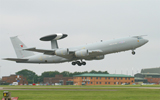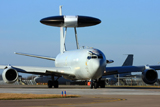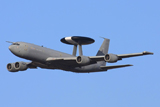Boeing E3 Sentry

Boeing E-3D Sentry - ZH105
In June 1965, the United States Air Force asked for proposals for feasibility studies into the provision of an Airborne Early Warning and Control system to replace the Air Force's existing EC-121 Warning Stars, which served in the Airborne Early Warning role, taking advantage of improvements in radar technology which allowed airborne radars to "Look Down" and detect low flying aircraft, even over land, which would previously be undetectable due to ground clutter. Contracts were given to Boeing, Douglas and Lockheed, with Lockheed being eliminated in July 1966. In 1967, a parallel program was put into place to develop the radar, with Westinghouse and Hughes being asked to compete to supply the radar for the new aircraft.
In 1968 it was referred to as Overland Radar Technology (ORT) during development tests on the modified EC-121Q. The Westinghouse radar antenna was going to be used whoever won the radar competition, and the first two were placed on the two "brass board" test aircraft which began flights in March 1972 and ended in July 1972. Westinghouse had pioneered the design of high power RF phase shifters (called Fox Phase Shifters after Gardner Fox of Bell Labs).
Early Boeing proposals for an aircraft based on the Boeing 707 were powered by eight General Electric TF34 engines, and carrying its radar in a rotating rotodome mounted at the top of a forward swept tail, above the fuselage. Boeing was selected ahead of McDonnell Douglas's proposal based on the DC-8 in July 1970. Initial orders were placed for two aircraft, designated EC-137D as test beds to evaluate the two competing radar designs. As the test-beds did not need the same 14 hour endurance demanded of the production aircraft, the EC-137s retained the normal Pratt & Whitney JT3D engines of the airliner, and a later reduction in endurance requirement led to retaining the normal engines in production.
The first of the two EC-137s first flew on 9th February 1972, with the fly-off between the two radars beginning in March and continuing until July that year. As a result of these tests, the Westinghouse radar was chosen for the production aircraft. The Hughes radar was initially thought to be a sure thing, because much of the design was also going into the new F-15 radar program. The Westinghouse radar used a pipelined FFT (Fast Fourier Transform) to digitally resolve 128 Doppler frequencies, while the Hughes used analog filters from the F-15 design. The Westinghouse team won the competition by having a programmable 18-bit computer that software was modified before each flight, and for multiplexing a Beyond The Horizon (BTH) mode that could complement the Pulse Doppler radar mode. This proved beneficial when the BTH mode was used to detect ships when the beam was directed below the horizon.
Approval was given on 26th January 1973 for full scale development of the AWACS aircraft, with orders being placed for three pre-production aircraft to allow further development of the aircraft's systems, with the first of these aircraft flying in February 1975. One change was that, in order to save costs, the endurance requirements were relaxed allowing the new aircraft to retain the four JT3D (US Military designation TF33) engines. IBM and Hazeltine were selected to develop the mission computer and display system. The IBM computer receiving the designation 4PI, and the software is written in JOVIAL. A SAGE or BUIC operator would immediately be at home with the track displays and tabular displays, but differences in symbology would create compatibility problems in tactical ground radar systems in Iceland, Europe and Korea over Link-11 (TADIL-A).
Modifications to the Boeing 707 for the E-3 Sentry included a rotating radar dome, single-point ground, and air refueling points, and a bail-out chute. The original design called for two bail-out chutes (one forward, and one aft) but the aft bail-out chute was deleted as a way to cut mounting costs. The use of parachutes was also deleted in the 1980s, as a way to save training and equipment costs. Since the parachutes were not issued to crew-members, but instead stored in the aft part of the plane, equipment additions left no place to store them. This also allowed the U.S. and NATO to drop the requirement for helmets which took hundreds of man-hours to inspect, repair, and maintain.
Since the Boeing 707 is no longer in production, a E-3 mission package has been fitted into the Boeing E-767 for the Japan Air Self Defence Force. The E-10 MC2A was intended to replace the United States operated E-3 (along with the RC-135 and the E-8 Joint STARS), but the E-10 program was canceled.
The USAF is now taking a new direction with the E-3 platform in order to bring it up to current technological standards. Boeing is currently testing its block 40/45 modified E-3. This aircraft represents the direction the USAF wants to take with its next upgrade of the Mission Crew section and Air Battle Management section of the E-3 fleet.
Another program under consideration is the Airframe Modernization Program (AMP). AMP would provide the E-3 with a glass cockpit and possibly re-engine the USAF fleet of E-3's with an engine that is more reliable and at least 19-22% more fuel efficient (the engines would pay for themselves in 4–5 years of use through fuel savings). New engines would give the USAF E-3's a longer range, longer on station time, shorter critical runway length (the E-3 could now operate with a full fuel load on a runway with only 10,000 feet at higher temperatures and pressure altitude) while providing better range for its line of sight sensors.
Now that the E-8 Joint STARS is being fitted with the P & W JT8D-219 (publicized as being half the cost of the competing 707 re-engine powerplant the CFM-56), the Air Force is again studying the possibility of moving forward to upgrade its current obsolete engines. However funding is currently unlikely since most upgrades to the E-3 fleet are not considered as essential at this time due to the current wars being fought.



Engineering, test and evaluation began on the first E-3 Sentry in October 1975. In March 1977 the 552nd Airborne Warning and Control Wing, now the 552d Air Control Wing at Tinker Air Force Base, Oklahoma received the first E-3 aircraft. In total, 68 aircraft were built, with 2 hull losses (one USAF aircraft, one NATO aircraft). The United States Air Force have a total of 33 E-3s in active service.
NATO acquired 18 E-3As and support equipment for a NATO air defense force. Since all aircraft must be registered with a certain country, the decision was made to register the 18 NATO AWACS planes with Luxembourg, a NATO country that until that point had not had any air force. The first NATO E-3 was delivered in January 1982. Presently 17 NATO E-3As are in the inventory, since one NATO E-3 was lost in a crash
NATO members United Kingdom and France are not part of the NATO E-3A Component, instead procuring E-3 aircraft through a joint project. The UK and France operate their E-3 aircraft independently of each other and of NATO. The UK operates seven aircraft and France operates four aircraft, all fitted with the newer CFM56-2 engines. The British requirement came about following unsatisfactory tests with modified Hawker Siddeley Nimrod aircraft to replace the Avro Shackleton AEW platform during the 1980s, with an order being placed in February 1987, deliveries starting in 1990. The other operator of the type is Saudi Arabia which operates five aircraft, all fitted with CFM56-2 engines. Japan has four Boeing E-767 aircraft equipped to similar standards.
E-3 Sentry aircraft were among the first to deploy during Operation Desert Shield where they immediately established an around-the-clock radar screen to defend against Iraqi forces. During Operation Desert Storm, E-3s flew more than 400 missions and logged more than 5,000 hours of on-station time. The data collection capability of the E-3 radar and computer subsystems allowed an entire air war to be recorded for the first time in history. In addition to providing senior leadership with time-critical information on the actions of enemy forces, E-3 controllers assisted in 38 of the 40 air-to-air kills recorded during the conflict.
| Model | Production |
|---|---|
| EC-137D | 2 built (both prototypes) |
| E-3A | 48 built (25 for USAF, 18 for NATO, 5 Saudi Arabia) |
| KE-3A | 8 built (all tankers for Saudi Arabia) |
| E-3B | 24 (all E-3A conversions) |
| E-3C | 27 (9 new build airframes, 18 E-3A conversions for NATO) |
| JE-3C | 1 built (trials airframe) |
| E-3D | 7 built ( all for RAF) |
| E-3F | 4 built (all for French AF) |
| E-3G | Current USAF Block 40/45 modification designation. |
| Sentry AEW.1 | RAF designation for the E-3D |
| Length: | 152.92ft (46.61m) |
| Width: | 145.73ft (44.42m) |
| Height: | 41.34ft (12.60m) |
| Accommodation: | 18 |
| Hardpoints: | 0 |
| Empty Weight: | 161,996lbs (73,480kg) |
| MTOW: | 324,961lbs (147,400kg) |
| Max Speed: | 531mph (855kmh; 462kts) |
| Max Range: | 4,598miles (7,400km) |
| Rate-of-Climb: | 2,000ft/min (610m/min) |
| Service Ceiling: | 41,010ft (12,500m; 7.8miles) |
| Engine: | Four CFM 56 2A-3 turbofans developing 24,000lbs each |
| Armament Standard: | None |
| Armament Optional: | None |
